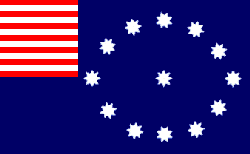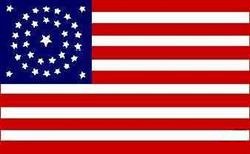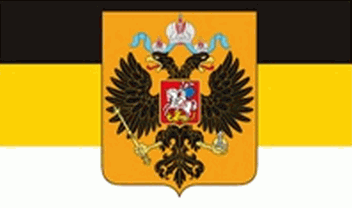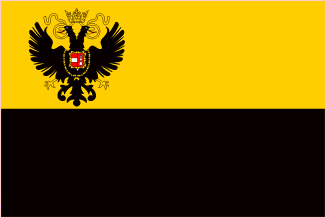Note: If an image ever fails to appear - refresh your page, it really is there
The Flags of the Poles and Poland - Part 2
1795 to 1926
| Top of Page | Medieval Poland 900 to 1599 | 17th and 18th Century Poland 1600 to 1795 |
| Alliance of the Three Black Eagles (Poland Partitioned) 1795 to 1807 | Napoleonic Era and Poland 1807-1824 |
| The Congress of Vienna and its Aftermath 1820-1914 | World War I and the Parliamentary Democracy 1914 to 1926 |
| Second Republic of Poland (Sanacja) 1926 to 1939 | World War II (German and Soviet occupation) 1939 to 1945 |
| People's Polish Republic (Communist regime) 1945 to 1999 | Third Republic of Poland 1999 to present |
The Alliance of the Three Black Eagles 1795-1807
The Partitioning of Poland
By the 18th century the nobles' "democracy" of Poland had gradually declined into anarchy, making the once powerful Commonwealth vulnerable to foreign intervention. Over the course of three successive partitions by the countries bordering it (the Russian Empire, Habsburg Austria and the Kingdom of Prussia), the Commonwealth was significantly reduced in size and ultimately ceased to exist in 1795. Therefore, from 1795 to 1807, the only legal flags on the territory of the partitioned Poland were those of the "Alliance of Three Black Eagles."
|
|
|
|
|
Russian Empire |
|
Kingdom of Prussia |
|
Habsburg Austria |
The idea of Polish independence, however, was kept alive throughout the 19th century and led to several Polish uprisings against the partitioning powers, the Russian Empire, and the Second Reich.
The Prussian Part
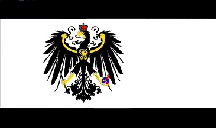
Kingdom of Prussia Flag
|
The Kingdom of Prussia Flag 1701-1918
The Kingdom of Prussian eventually became the North German Federation between 1867 and 1871. Under the leadership of Kaiser Wilhelm II and Otto von Bismarck they formed Imperial Germany or the Second Reich (Second Empire).
By 1863, Prussia and Russia were well into the process of dividing-up Poland and making German or Russian provinces of its lands to add to to their individual growing empires. This is sometimes referred to as the partitioning of Poland. Soon the Prussian landscolors of "black and white" would replace the "red and white" on the flags of Poland.
|

Flag of West Prussia
|
Flag of West Prussia Province 1886-1920
West Prussia was a province of the Kingdom of Prussia from 1773-1824 and 1878-1919/20 which was created out of the earlier Polish province of Royal Prussia.
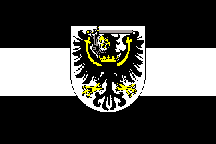 State Flag of West Prussia State Flag of West PrussiaAfter Germany was defeated in 1918, in February 1920 it handed over West Prussia's central parts to become the so-called Polish Corridor and the Free City of Danzig, while the parts remaining with the German Weimar Republic became the new Posen-West Prussia or were joined to the Province of East Prussia as Regierungsbezirk West Prussia. The territory was included within Reichsgau Danzig-West Prussia from 1939-45, after which it became part of Poland.
|
The Austrian Part

Galicja Lodomeria 1809-1849
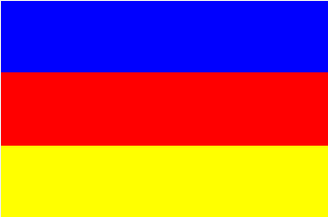
Galicja Lodomeria 1849-1890
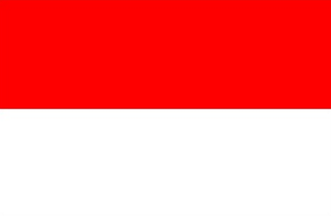
Galicja Lodomeria 1890-1918
|
Galicja Lodomeria Flags 1809-1918
At first, the Austrian rule was just as repressive and harsh as the Prussian and Russian were, but later it became the mildest of them all. The Habsburg Empire declined to take part in the Second Partition in 1793, but joined the others in the final one in 1795. It added to the traditional Galicia (Galitzien) a large chunk of what was called then West Galicia with the city of Lublin. The western part of the traditional Galicia was populated by the Poles while the eastern one by the majority of Ukrainians (Ruthenians) with Polish and Jewish minorities. In 1807, the Polish and Saxon armies took away from Austria the so-called "West Galicia" and it was incorporated in the independent Duchy of Warsaw. The congress of Vienna didn't reverted that province back to Austria, allocating it to the Congress Kingdom of Poland (under Russian rule) instead. The traditional Galicia became the Kingdom of Galicia and Lodomeria, subject of the Austro-Hungarian Empire (Königreich Galizien und Lodomerien - Krölestwo Galicji i Lodomerii) a Kronland of Austria. Capital of the Kingdom was in Lvov (Lwów, Lemberg).
Nonetheless, early in the 20th century, with the Ukrainians leaning toward Russia, the Austrians gave the Poles reins of the local government, own Parliament (Sejm), Polish viceroy and Polish as the official language. The talk began about the federalization of the Empire with Galicia-Lodomeria becoming an equal part of it along Austria and Hungary with, perhaps, Bohemia added too. The poor economy of Galicia forced many people to emigrate - Poles to the U.S. and Brazil, Jews to New York, and Ukrainians to Canada. Then came the World War I.
The great Polish patriot and leader, Józef Pilsudski, arranged with the Austrians the formation of the Polish Legion to fight the Russian. He was motivated with the thesis that while temporarily he will be allied with the Central Powers fighting the common enemy, they will lose the war with the Western Allies, and Poland would be recreated from all parts of the partitions, united and strong. His idea was to rekindle the spirit of the glory of the Commonwealth by uniting many Central and Eastern nations into the free federation, which he had called Miedzymorze - "Intermarrum", of independent but interconnected countries which together will form a strong buffer between historically expansionist powers of Russia and Germany, none of which knew the democracy and which people were never really free - just mere subjects of the states and sovereigns. His thesis proved to be right to a large degree, but his dream of uniting all the nations between Russia and Germany failed. It received a varying, sometimes enthusiastic, support from Finland, Estonia, Latvia, Crimean Tatars, Kuban Cossacks, some Ukrainians, Hungarians, Romanians, Yugo-Slavs and Turks. However, the Lithuanians, the Czechs and the majority of the Ukrainians, mistrustful of the Polish ideas rejected it outright. Besides, nobody predicted a severe revolution in Russia, which changed all of the balances of power and faced the world with the new challenges of ideological expansionism. |
The Russian Part
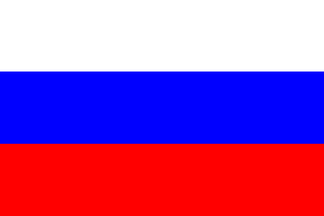
Russian National flag 1772

Flag of Russia 1772
(Naval Ensign)
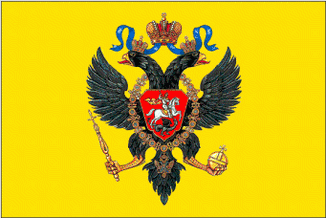
Russian Empire 1772
(Imperial Standard)
|
Russian Empire 1772
The Russian military successes in its territorial expansion in pursuit of warm-water ports made the other states of Eastern Europe uneasy. These anxieties were overcome by an extraordinary division of Polish territory known as the First Partition of Poland. The Russian victories along the Danube River were most unwelcome to Austria, which also had ambitions of territorial expansion in that direction. After long secret negotiations, Russia agreed to abandon the conquered Danubian provinces. In compensation, it received a large portion of Polish territory with almost 2 million inhabitants.
In September 1772, the helpless Polish aristocracy ratified this seizure of nearly one third of Polish territory. The loss was not necessarily fatal to Poland´s continued existence, and it inspired a revival of national feeling. Attempts were made to strengthen the Polish state and reform its feeble central government, but they proved to be too little and too late.
The final two partitions of Poland occurred as a direct result of fears by the eastern powers that the principles of the French Revolution were establishing themselves in Poland. In 1791, a group of nobles known as the Polish Patriots actually issued a new constitution that substituted a hereditary for an elective monarchy, proved for real executive authority in the monarch and his council, established a new bicameral diet, and eliminated the librium veto. Frederick William II of Prussia promised to defend the new Polish constitutional order because he believed that a stronger Poland was in Prussia's interest against the growing Russian power. Catherine the Great of Russia also understood that a reformed Polish state would diminish Russian influence in Poland and Eastern Europe.
In April 1792, conservative Polish nobles who opposed the reforms invited Russia to restore the old order. The Russian army quickly defeated the reformist Polish forces. However, rather than protecting Poland as he had promised, Frederick William carried out a second partition of Poland. The reformed constitution was abolished, and the new Polish government remained under the influence of Russia.
In 1794, Polish officers rebelled against uniting with the Russian army. The partitioning powers decided to erase any independent Polish state from the map. On October 1795, the representatives of the powers divided the remaining territories between their three countries. Prussia, Austria, and Russia sent troops into Poland. On November 4, Russian troops killed over 10,000 Poles outside Warsaw. The three totalitarian powers portioned what remained of Poland among themselves. |
| Top of Page | Medieval Poland 900 to 1599 | 17th and 18th Century Poland 1600 to 1795 |
| Alliance of the Three Black Eagles (Poland Partitioned) 1795 to 1807 | Napoleonic Era and Poland 1807-1824 |
| The Congress of Vienna and its Aftermath 1820-1914 | World War I and the Parliamentary Democracy 1914 to 1926 |
| Second Republic of Poland (Sanacja) 1926 to 1939 | World War II (German and Soviet occupation) 1939 to 1945 |
| People's Polish Republic (Communist regime) 1945 to 1999 | Third Republic of Poland 1999 to present |
The Napoleonic Era in Poland and its Aftermath 1807-1848
The free-spirited Poles, founding themselves under the yoke of the occupation by the repressive, totalitarian regimes, started looking with great hope to the potential savior - Napoleon Bonaparte. The patriotic emigrants joined in droves the Polish Legions of the Napoleon's army and participated in all of his campaigns, including Egypt and Haiti.
Inside Poland, Napoleon Bonaparte became second only to the God in affection of the people. After the victories over Prussians, Napoleon did indeed restore the Polish statehood, albeit in very limited form, mostly from the Prussian part of the partitions, disappointing many Poles.
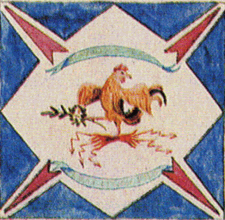
Dabrowski Legion Standard
Italian Campaign |
Polish Legion of General Dabrowski 1801
This was the standard used by the legion of Polish General Jan Henryk Dabrowski (1775-1818) in Napoleonic Italy. Dabrowski is mentioned in the first stanza of the Polish National Anthem: "March, March Dabrowski, from the Italian soil to Poland..."
Dabrowski is remembered in the history of Poland as the organizer of the famed Polish Legions in Italy during the Napoleonic Wars. In 1796, he was summoned to Paris by Napoleon Bonaparte to create Polish legions, which would be part of the army of the newly created Republic of Lombardy. This was a year after the Third Partition of Poland between Russia, Prussia and Austria. Poland had disappeared from the map of Europe, thus the legions were to consist of Polish exiles.
Dabrowski managed to preserve the traditional Polish uniforms, national insignia and the Polish officer corps, although their epaulettes now bore the colors of Lombardy and the French tri-colour. Within a short time, he gathered seven thousand troops, whom he turned into a disciplined army. Dabrowski's Polish Legion fought with honor at Napoleon's side from 1797 until the beginning of 1803 during his campaign in Italy. However, the legions were never able to reach Poland and did not liberate the country, as Dabrowski had dreamed.
General Dabrowski, who had retired after his campaign in Italy, joined the command of Prince Poniatowski in 1808 to fight the Austrians. He campaigned with Poniatowski until the Battle of Leipzig (1813), but in the following year his injuries forced him to returned to Poland, unable to continue the fight any further. He was one of the generals entrusted by the Tsar with the reorganization of the Polish army, and was named in 1815, General of Cavalry and Senator of the new Congress Kingdom, and awarded the Order of the White Eagle. He retired in the following year to his estates in Winnogóra near Poznan, where he died in 1818. He wrote several well-known military historical works in Polish. |
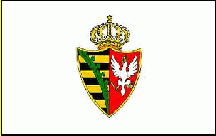
Warsaw Duchy
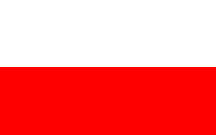
Warsaw Duchy Bicolor
|
The Warsaw Duchy 1807-1814
Tsar Aleksander (then still friend of Napoleon) didn't agree on the name "Kingdom of Poland" citing the abdication of the last king, Stanislaus Augustus Poniatowski, so the new entity adopted the name: "Duchy of Warsaw" (Ksiestwo Warszawskie - Duché de Varsovie - Herzogtum Warschau). The ruler of the Duchy was selected by Napoleon according to the line of succession established by the May 3rd Constitution of 1791 and he was the grandson of the King August III, member of the House of Wettin and Elector of Saxony (ally of Napoleon) Prince Fryderyk August (Friedrich August).
The Duchy, nominally independent, was in reality a French protectorate. In 1809, the Polish and Saxon armies defended the Duchy against the Austrian invasion without any French support. When the French won the war with Austria, the Duchy was enlarged by the parts of the Austrian partition, but not by the all territories of Gaicja (Galizien) liberated by the Polish-Saxon armies of Prince Jozef Poniatowski, War Minister of the Duchy, nephew of the last king of Poland, later Marshal of France.
Another wave of great hope came with the start of the French invasion of Russia. 100,000 of Polish troops, under Prince Poniatowski, joined the Napoleonic Army reaching Moscow, but it was their valiant task to protect the French Emperor from the capture by the Russians in his hasty retreat which remained in the memory of the Poles. The Big Dream became just that.
There were a couple of versions of the Duchy flag: one of the official flags of the Duchy (coat-of-arms on the white field) and a second was a plain, white over red horizontal stripes was also used there.
|
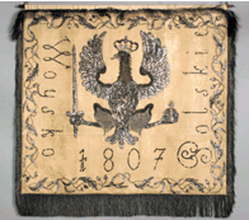
Poniatowski Legion Standard
Duchy of Warsaw
Napoleonic Campaigns
|
Standard of the Polish Army of the Warsaw Duchy 1807
This was the Standard of the Polish Army of the Duchy of Warsaw under the command of Field Marshall Prince Józef Antoni Poniatowski. Prince Poniatowski (1763-1813) was a general, minister of war and army chief, who became a Marshal of Napoleon. Poniatowski was a career soldier, first in the Austrian imperial army, later in newly formed Polish army as Lieutenant-General and commander of the Polish army in the Ukraine, with the task of defending the country against the imminent Russian attack. The Polish-Russian War was followed by the Second Partition of Poland. It gave rise to four decades of intense warfare aimed at preserving Poland's independence.
Prince Poniatowski joined the Kosciuszko Insurrection in 1794, and with its failure he retired from the military. In 1806, Poniatowski was asked by the Prussian King Frederick William III to assume the governorship of Warsaw, which he did. However, in 1807, the Duchy of Warsaw was established in the recaptured territories as a satellite of Bonaparte's France, and Poniatowski became officially Director of the Department of War and set about organizing the Polish army. Polish General Dabrowski, who had retired after his campaign in Italy, joined the command of Prince Poniatowski in 1808 to fight the Austrians. In 1809, Poniatowski led his army against an Austrian invasion and fought them to a standstill, and after the Battle of Raszyn, his army entered Galicia and re-captured Kraków. Poniatowski and Dabrowski then became involved in Napoleon's disastrous invasion of Russia.
In the retreat of Napoleon's army from Moscow, Poniatowski, now a Field Marshal was entrusted with the dangerous duty of covering the French Army's retreat. Later both he and Dabrowski heroically defended Leipzig, losing half his troops in the attempt, finally falling back slowly upon a bridge over the Weisse Elster River, near Leipzig. In the general confusion, the French blew up the bridge before he could reach it. Contesting every step with the overwhelming forces of his pursuers, Prince Józef refused to surrender, and covered with wounds plunged into the river. There he died, probably shot by French troops' friendly fire from the opposite bank of the Elster River. |
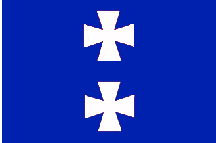
Free City of Danzig
|
Free City of Danzig (Gdansk) 1807-1814
Although the Poles were hoping that Napoleon will give them the access to the sea by attaching Danzig (Gdansk) to the Duchy of Warsaw, he decided to make it a Free City under nominal Prussian-Saxon protection (de facto a French protectorate).
During it existence, the Free City suffered great destruction, first in the process of the French takeover from the Prussians and later from the Russian and Prussian assault on it. The Congress of Vienna in 1815 liquidated the Free City and it reverted to Prussia. The flag resembled the flags of the later Free City (1920-39), but was distinctively "French."
|
| Top of Page | Medieval Poland 900 to 1599 | 17th and 18th Century Poland 1600 to 1795 |
| Alliance of the Three Black Eagles (Poland Partitioned) 1795 to 1807 | Napoleonic Era and Poland 1807-1824 |
| The Congress of Vienna and its Aftermath 1820-1914 | World War I and the Parliamentary Democracy 1914 to 1926 |
| Second Republic of Poland (Sanacja) 1926 to 1939 | World War II (German and Soviet occupation) 1939 to 1945 |
| People's Polish Republic (Communist regime) 1945 to 1999 | Third Republic of Poland 1999 to present |
The Flags of the Congress of Vienna and its Aftermath 1820-1914
When the partitioners got partitioned as the armies of France under the brilliant leadership of Napoleon rewrote the map of Europe, they were determined to put everything back to where it had been before when he was finally defeated. This led to the establishment of "The Congress Kingdom of Poland," created by the Congress of Vienna, to provide a new, post-Napoleonic, order in Europe. The Congress Kingdom was set up on the territories of the Russian part of the partition of Poland, with minor adjustments. It was supposed to form a completely autonomous country in the personal union with Russia, where the Russian Tsar was also to be the King of Poland.
The Congress of Vienna also obliged the Prussian Kingdom to create an autonomous Grand Duchy of Poznan (Posen) and the Austrians to allow Kraków (Cracow) to function as the fully autonomous Republic (Free City). All three powers involved in the liquidation of the Polish-Lithuanian Commonwealth disregarded the decisions of the Congress and began quickly to abolish the, initially substantive, autonomy of the Polish territories under their control. Untold number of the patriotic Poles were deported to Siberia, Caucasus and the Far East, and the Russian Secret Police was everywhere watching and arresting. The same was done by the Prussians, Only the Austrian administration of occupied Polish territories seemed somehow more benevolent and slightly milder.
The Russian Part
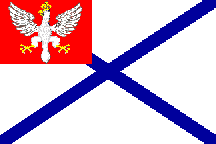
Civil Ensign of Poland
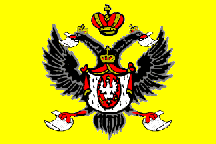
Czar's Standard of Poland
(at Sea)
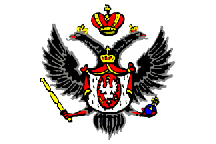
Czar's Standard of Poland
(on Land)
|
The Congress Kingdom of Poland Ensigns 1815-1848
This flag was used in 1784-1787 as ensign of Black Sea Trade Company. Constituted by Czar Alexander I, as banner of the Kingdom of Poland, this flag was certainly used since 1827 by two of Vistula's steam ships. Poland was now completely controlled by Russia, as can be demonstrated by this ensign showing the Polish white eagle in a canton placed over a field of the Flag of Russia.
This ensign is that of the Kingdom of Poland (commonly known as the Congress Kingdom of Poland) created at the Congress of Vienna. It was set up on the territories of the Russian part of the partition of Poland and was supposed to be a fully autonomous country in a personal union with Russia, whereby the Russian Tsar was also the King of Poland.
Under the first viceroy, who was the Polish Napoleonic general, Jozef Zajaczek, Polish was the official language, the schools and universities functioned normally, even the army, albeit small, was strictly Polish. But all this slowly eroded in the repressions that followed the November Uprising of 1830, and after the January Uprising of 1863, all vestiges of autonomy were liquidated, including changing Poland's name to "Nadvislanskiy Krai" (Vistula Land), dividing it into Russian provinces, and instituting Russian as the only official language. Untold number of the patriotic Poles were deported to Siberia, Caucasus and the Far East, and the Russian Secret Police was everywhere watching and arresting.
This flag became a civil ensign and is universally accepted as a flag representing this "Kingdom." The other two flags, the Russian Imperial tsarist ones, were the only legal flags for the Congressional Kingdom of Poland between 1815-1830. This was the Czar's Ensign of Kingdom of Poland (Congressional) used on land only.
The Kingdom of Poland, also called the "Congress Kingdom" with its capital in Warsaw, was autonomous, with the Russian Tzar as ruler (1815-1831). The Kingdom of Poland Flag (1784-1787) showed the Russian St. Andrew's blue saltire with Polish eagle in canton. During November Uprising against Tzar in 1831, the Polish Parliament (Sejm) abolished this flag and adopted as the Polish national flag the horizontal white-red bicolor. After the suppression of Uprising, the Czar didn't restore the flag. Of course, he also didn't accept white-red flag.
Until World War I only Russian flags and Russian Imperial Coat-of-Arms like this one and the one below were legal. Even municipal coat-of-arms were prohibited. It is interesting to note, that the Imperial Grand Coat-of-Arms retained the Polish symbol of the White Eagle on red on its wing all the way until 1917. |
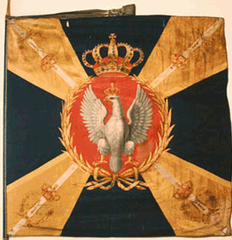
Zajaczek Legion Standard |
Standard of the Polish Army of the Congress Kingdom
This was the Standard of the Polish Army of the Congress Kingdom of Poland under the command of the Viceroy General Zajaczek, representing Tsar Alexander of Russia as the King of Poland.
|

November Uprising
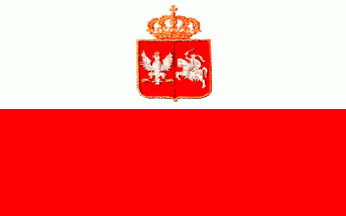
November Uprising Variant
|
Flag of the November Uprising 1830-1831
In 1830, group of young Polish officers began an uprising in Warsaw and it soon spread rapidly to every corner of Poland and Lithuania. Although, the Polish rebels achieved initial victories over Russian troops and temporarily liberated large swats of the country, they were eventually crushed by the overwhelming force of the Tsar's Army under Field Marshal Ivan Paskevich.
During the November Uprising different flags designs were introduced and used locally. The colors of white and red on the flags of this period were commonly used as revolutionary and democratic flags.
The Polish flag in the horizontal arrangement of white over red was first instituted officially during this uprising, sometimes with the Arms of the Commonwealth placed on the white band.
( Click here for more information about this Polish Coat-of-Arms ) |
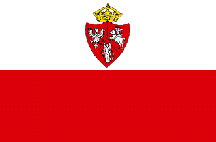
January Uprising Flag
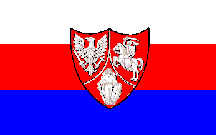
January Uprising Variant
|
Flag of the January Uprising 1863-1864
A Russian attempt of conscription for 20-year service of all young Polish activists sparked the spontaneous outbreak of the January Uprising against the Russian Empire, which was soon supported by the high-ranking Polish and Lithuanian officers and politicians. In February of 1863, Prussia formed an alliance with Russia to repress this revolt. Not sufficiently armed and lacking popular support in many parts of the country, the young rebels conducted a guerrilla war, often heroic in nature, but ultimately doomed.
The Provisional Government of the Uprising used as its symbol a modified Coat-of-Arms, which included the representation of Rus (Ukraine) - Archangel Michael, wielding a flaming sword and a shield. The flags used were often tricolor to underline the ideals of brotherhood of the nations of the former Commonwealth. The tri-color flags of white-red-blue appeared only during the January Uprising of 1863-64, not during the November Uprising of 1830-31, and never after. ( Click here for more information about this Polish Coat-of-Arms ) |
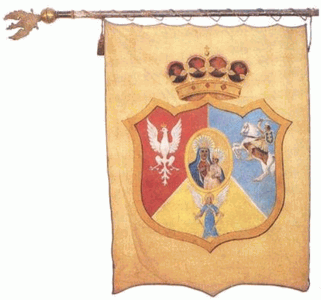
January Uprising Standard |
January Uprising Standard 1863
This was one of the battle standards used by the Polish rebels during the desperate January Uprising which started in 1863 and ended in 1865.
It began January of 1863 and ended with the capture of the last insurgents in 1865. Severe Russian repressions followed, with thousands executed and tens of thousands deported to Siberia and elsewhere in Russia. All traces of Polish autonomy were removed and Russian became the only official language. Many estates were confiscated from the nobility and the severe war indemnity was imposed on the Poles, and in March, Russia divided Poland into provinces. |

Free City of Kraków
|
Free City of Krakow 1815-1846
The city of Kraków (Cracow - Krakau), the ancient capital of Poland, was separated from Galicia by the decision of the Congress of Vienna and made an autonomous city state, the Free City of Cracow ( formal name: Free, Independent and Strictly Neutral City of Cracow with its Territory - Wolne,Niepodlegle i Scisle Neutralne Miasto Kraków z Okregiem). It was under the protection of Austria Russia and Prussia, with Austria exercising actual control, but with enough independence to become a center of political thinking and activities for all parts of the occupied Poland and the Jagiellonian University as a beacon of Polish education.
|
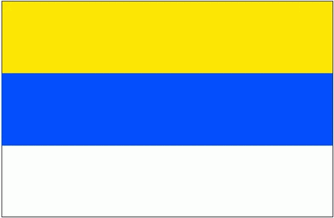
Grand Duchy of Krakow
|
Grand Duchy of Krakow 1846-1918
In 1846 the uprising in Krokow and other parts of Galicia was quashed by the skillful game of the Austrians to play the independent-minded Polish gentry and intelligentsia against the poor, but liberated from serfdom, complacent peasants and the Polish-Ruthenian animosities as well. In result, the Free City was annexed by Austria and made a part of Galicia-Lodomeria again as the Grand Duchy of Krakow, part of Austria for the administrative
purposes but formally a separate entity, albeit with the previous autonomy rescinded. Galicia started to recover some autonomy after a decade of the absolute rule by the Austrian, but the conflicts between the Poles and Ruthenians (Ukrainians) allowed the Austrians to limit that amount of autonomy to just window-dressing.
|
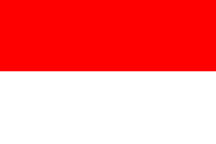
Grand Duchy of Poznan
|
The Grand Duchy of Poznan (Posen) 1815-1848
The Grand Duchy of Poznan (Posen) was part of the Kingdom of Prussia, created from territories annexed by Prussia after the Partitions of the Polish-Lithuanian Commonwealth, and formally established following the Napoleonic Wars in 1815. Per agreements derived at the Congress of Vienna it was to have some autonomy. However in reality it was subordinated to Prussia and the proclaimed rights for Polish subjects were not fully implemented. The name was unofficially used afterward for denoting the territory, especially by Poles, and today is used by modern historians to describe different political entities until 1918. Its capital was Posen (Poznan).
The Grand Duchy was formally replaced by the Province of Posen in the Prussian constitution of 1848. |

Flag of Posen
|
Flag of Posen Province 1882-1918
The Province of Posen was a province of Prussia from 1848–1918 and as such part of the German Empire from 1871 to 1918. The territory of later province, roughly corresponding to the region of Greater Poland, had become Prussian in 1772 (Netze District) and 1793 (South Prussia) during the partitions of Poland.
After Prussia's defeat in the Napoleonic Wars, the territory was attached to the Duchy of Warsaw in 1807 during the Treaty of Tilsit. In 1815 during the Congress of Vienna, Prussia gained the western third of the Warsaw duchy, which was about half of former South Prussia. Prussia then administered this province as the semi-autonomous Grand Duchy of Posen. This region was inhabited by Polish majority and German and Jewish minorities and a smattering of other peoples.
In 1919, during the Treaty of Versailles, Weimar Germany ceded the bulk of the province to the newly established Second Polish Republic. When World War II ended in 1945, it was overrun by the Red Army who turned it over to the People's Republic of Poland. |
| Top of Page | Medieval Poland 900 to 1599 | 17th and 18th Century Poland 1600 to 1795 |
| Alliance of the Three Black Eagles (Poland Partitioned) 1795 to 1807 | Napoleonic Era and Poland 1807-1824 |
| The Congress of Vienna and its Aftermath 1820-1914 | World War I and the Parliamentary Democracy 1914 to 1926 |
| Second Republic of Poland (Sanacja) 1926 to 1939 | World War II (German and Soviet occupation) 1939 to 1945 |
| People's Polish Republic (Communist regime) 1945 to 1999 | Third Republic of Poland 1999 to present |
The Flags and Banners of World War I and the
Second Republic of Poland (Parliamentary Democracy) 1919-1926
With the defeat of Imperial Germany in 1918 the Poles once again had a chance to re-establish their country. In the years 1914 and 1919, there was a whole rash of small Polish towns, cities, and areas briefly declaring their independence as republics, before being joined together as parts of a larger Second Republic of Poland.
Between 1919 to 1926, in the first phase of the Second Republic (which we will call the "Parliamentary Democracy"), Poland had a multi-party democratic system which clearly allowed the supremacy of the legislature over the presidency (executive power) to prevail. That system was codified in the very democratic constitution of 1921. Unfortunately, conditions for its survival, both economic and political, were not ideal with the Great Depression looming.
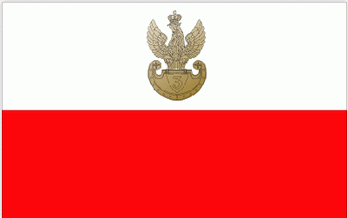
One of the flags of Pilsudski's Legions - 3rd Infantry Regiment
|
Polish Legions of Pilsudski 1914-18
This is one of the flags used by an independent Polish military formation created within the Austro-Hungarian Army to fight the Russians, on the initiative of Józef Pilsudski, a great fighter for the Polish independence and the future leader of the country. His idea was to temporarily align the Poles with the Central Powers to fight the common enemy (Russia), and to extract from them concessions leading to the laying out the foundations for the restoration of the Polish statehood. His assumption was that the Central Powers (Germany and Austria-Hungary) would lose the war with the Western Allies, and it will open the way to re-establish a the unified and strong Polish State out of all the territories partitioned in 1795.
His way of thinking was proved right as the Central Powers, eager to gain support of the Poles in the war with Russia, declared the formation of the Kingdom of Poland on the territory of the so-called Vistula Land, taken from Russia in the course of the war campaigns of 1915-16. |
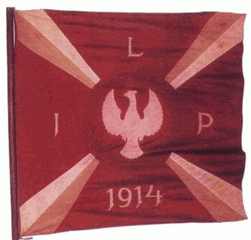
Pilsudski Legion Standard
|
First Polish Legion of Pilsudski 1914
This was the Standard of the First Polish Legion used during Pilsudski's struggle with the Rusians.
|
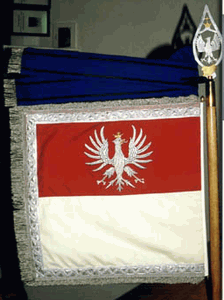
Ulhans of Krechowice
Cavalry Standard
|
Standard of 1st Regiment of the Ulhans (Cavalry) of Krechowice 1915
The 1st Regiment of the Ulhans (Cavalry) of Krechowice was a unit of Pilsudski's Legions formed in 1915. It was named after the village of Krechowice (near Stanislawow in Eastern Galicia) where it fought its first victorious battle against the Russians. In 1918-19 participated with distinction in the Polish-Ukrainian War helping to relieve the defenders of Lwow. Also, participated in occupation of Pomerania and in the ceremony of Poland's Wedding to the Sea, when the standard of it was dipped in the Baltic's waters.
In that ceremony, Gen. Józef Haller had thrown a platinum ring to the sea (the ceremony was repeated in 1945 when the Polish soldiers dipped their standards and flags in the cold water of the Baltic Sea on two occassions - Mrzezyno on March 17 and Bad Kolberg (Kolobrzeg) on March 18) The regiment then fought in the Polish Soviet War against Budionnyi's Horse Army.
In the September 1939 campaign it was one of the last regular Polish Army units to surrender - at Kock on October 6, 1939. Was reactivated in 1942 within Anders' Army in the USSR, went to Iraq, Palestine and Egypt, where it was equipped with Sherman tanks and shipped to Italy. Fought the battles of Ancona, helped to break the Gothic Line (Goten-Stellung) of Field Marshal Kesselring, and liberated Bologna.
The Home Army (AK) named one of its regiments after it too, in the Operation Tempest during the Warsaw Uprising of 1944, when it fought in the Augustow Forest.
standard of 1st Regiment of the Ulhans (Cavalry) of Krechowice |
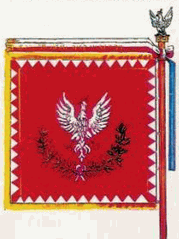
Lwów Defenders Standard
obverse side
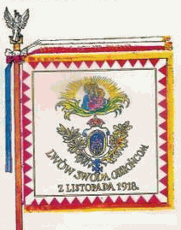
Lwów Defenders Standard
reverse side
|
The Defenders of Lwów Standard 1918
This standard was given by the grateful citizens of Lwów to their defenders. The legend on it says: "Lwów to its defenders - November 2, 1918."
Between 1914 and 1918, ferocious and bitter fighting took place in and around the City of Lwów between German, Austrian and Polish forces. In 1918, just at the end of World War I, the city found itself briefly occupied by Ukrainian and Austrian forces. The defenders of Lwów at this time were predominantly children and students (Lwów Eaglets; Lwówskie Orleta), who successfully, but with great losses of life, defended Lwów between November 1st and November 21st against the surprise occupation by about 3,000 Austrian and Ukrainian troops, just before the collapse of Austrian Empire.
The next year, Polish volunteers and their newly organized army blocked a 1920 invasion by the Bolshevik Red Army which hoped to spread Communism to Germany and Western Europe. Among these 1920 defenders one could also find Americans. They included World War I Ace Merian Cooper, an American whose great-great-grand father, Colonel John Cooper, befriended Polish Count Kazimierz Pulaski during the American Revolution, and Cedric Fauntleroy, who with 17 other volunteer Americans and 20 obsolute biplanes, organized the Kosciuszko Squadron in Lwów. Together with four Polish squadrons, they defending Lwów and Warsaw against the Soviet invasion in 1920. These brave pilots would drop bombs by hand on Soviet Cossack columns, then dive to strafe them with their machine guns.
In 1920, Cooper was shot down, taken prisoner by Soviets, and personally questioned by Stalin. He escaped thanks the help of an American journalist. For his exceptional courage and valor, Cooper was awarded the Virtuti Militari, the highest Polish military decoration. Later, he become a Hollywood producer, and in 1933, he co-wrote and directed the movie, King Kong, for which he received a special Oscar. He also has a star on the Hollywood Walk of Fame.
Eventually, in 1920, the Polish defense of Warsaw and Lwów was successful and the encircled and defeated Soviet Red Army withdrew. The Polish eastern borders were then established by the Riga Peace Treaty. Today, the "Cemetery of the Defenders of Lwów" or "Cemetery of Eaglets," is a memorial and a burial place for the more than 3000 Poles who died in Lwów during the hostilities of the Polish-Ukrainian War and Polish-Soviet War between 1918 and 1920. The cemetery, destroyed by Soviets tanks in 1971, was rebuilt in 1990s by volunteer workers of Energopol, a private Polish construction company, and by the citizens of Lwów. |
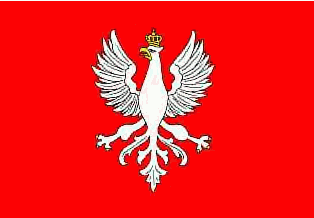
Regency Kingdom of Poland
(Plain white and red striped flags of Poland were also being used.)
|
Regency Kingdom of Poland 1916-1918
Jozef Pilsudski was proved right when the Emperors of Germany and Austria-Hungary proclaimed the creation of the Kingdom of Poland in 1916. It was just a German protectorate aiming to gather the Polish support for the war with Russia, nevertheless, it became the first concrete step in regaining Polish freedom. Unfortunately, the Germans had a sinister, secret plan to exploit this puppet state of its resources and by the way of famine, reduce the Polish population and to open the westernmost parts of it for the future German colonization.
On the surface it appeared to be a Polish State under the rule of the Regency Council, composed of Aleksander Cardinal Kakowski, Prince Zdzislaw Lubomirski and Count Jozef Ostrowski, all conservative politicians. The Polish language, banned under the Russians, was restored as official and Polish symbols, once again were representing the state. It was supposed to have its own army (Polnische Wehrmacht), but the actual power remained in the hands of the German Governor-General, Hans Hartwig von Beseler. In 1918, when it became apparent that the Central Powers were losing the war, the Regency Council dissolved itself transferring all powers to Pilsudski as the Chief of State, who proclaimed Poland independent and free. |
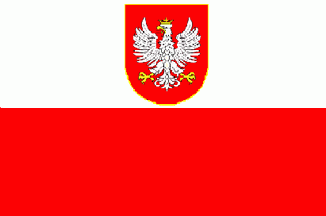
Polish National Committee
|
Polish National Committee - Paris 1917-1918
Opposing Pilsudski's alliance with the Central Powers and his socialist orientation, the nationalistic, but pro-Russian Polish politicians, organized the Polish National Committee (Komited Narodowy Polski) in 1914 in Petersburg with an office in Paris. The Committee formed two Polish armies, one in Russia and one in France.
The Russian Revolution forced the Committee to drop its pro-Russian stand, and its leadership under Roman Dmowski relocated to Paris to gather as much support for Poland's independence as possible. It is said that Ignacy Jan Paderewski, the world-renowned pianist and member of the committee, influenced his close friend President Woodrow Wilson to add Point 13 (form a fully independent Poland with the access to the sea) to his famous 14-points.
Although, disliking Pilsudski, the Dmowski's Committee recognized him as the head of the independent Polish State in Warsaw. Pilsudski, after making sure that all German and Austrian soldiers on Polish soil are disarmed and packed to head home, invited Paderewski to join the new Polish government as its Prime Minister, an offer which was eagerly accepted by him and the Committee. |
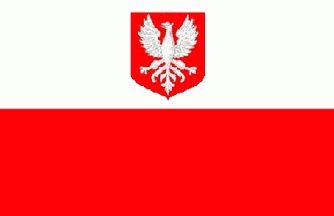
Provisional People's Government
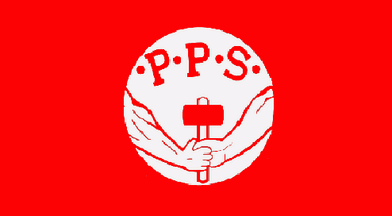
Polish Socialist Party -PPS
|
Provisional People's Government of the Republic of Poland
(Tymczasowy Rzad Ludowy Republiki Polskiej) November 7-12, 1918
Lublin, where the Provisional People's Government was formed on November 7, was under Austro-Hungarian occupation at the time. The Habsburg Empire was in disarray and the German collapse was anticipated at any time. A leftist dominated provisional Government, composed of members of three socialist parties, was declared that lasted 5 days.
In Warsaw, the Regency Council declared Poland independent on October 7, on October 19, the same happened in the Silesian Principality of Cieszyn (Teschen) and in Krakow, on October 28, the Polish Liquidation Commission was organized to prevent the Regency Council from taking Galicia under their control. All these moves were by the leftist movements to assure that the actual power in the reborn country wouldn't go to the ultra-conservatives of the Regency Council.
The Provisional Government issued a string of declarations announcing radical social reforms, but that was never implemented, due to the short lifespan of this government. It was led by the close friend of Jozef Pilsudski and fellow socialist - Ignacy Daszynski. On insistence of the Interior Minister of this government, Stanislaw Thugutt, the crown was removed from the eagle's head on emblems and flags.
On November 11, 1918, hearing the news of Pilsudski's taking power in Warsaw, Daszynski dissolved the People's Government, went to Warsaw, and accepted formally Pilsudski as the Chief of State.
Daszynski was nominated to be the first Prime Minister, but under protests from the Polish National Committee in Paris, withdrew. It has to be strongly noted, that government, although influenced by the Russian revolution undoubtedly, had nothing to do with the communist Soviets in Russia.
Although the "official" flag of the short-lived Republic of Poland had the bareheaded eagle centered on it, during the demonstrations and mass rallies, the flag most used was the red flag of the PPS (Polish Socialist Party). |
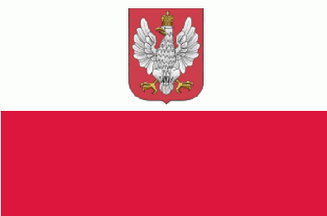
Republic of Zakopane
|
Republic of Zakopane (Rzeczpospolita Zakopianska)
October 13 - November 16, 1918
The Republic existed from October 13 to November 16 1918 in the area of the town of Zakopane and its surrounding villages. Zakopane was located in the Austrian part of the partitioned Poland. On October 13, 1918, during the citizen's meeting, 500 delegates voted for creating the National Organization in Zakopane and elected the famous Polish writer, Stefan Zeromski as its President. Their declaration recalled the Wilsonian principles for the new order in post-war Europe and asserted that citizens of Zakopane are from now on the subjects to free, independent and united Poland.
Formal declaration of independence was issued on Oct 30, 1918. On that day, the Polish officers and soldiers disarmed the Austro-Hungarian and German soldiers in the town and the National
Organization transformed itself into the National Council of the Republic of Zakopane, swore loyalty to Poland, and assumed all state powers on its territory. As the Council was dominated by the rightists and centrists, to make it more representative, some socialists were co-opted into it.
On November 16, 1918, when the Polish Liquidation Committee in Cracow took the power over all of Galicia, and the Republic of Zakopane was self-dissolved. The flag of the Republic was exactly like the state flag of Poland adopted in 1919 by the Polish Parliament (Sejm). |
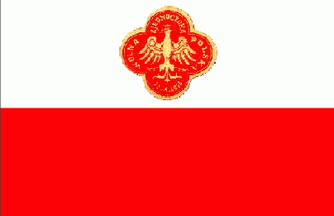
Polish Liquidation Commission
|
Polish Liquidation Commission of Galicia and Teschen Silesia
(Polska Komisja Likwidacyjna Galicji i Slaska Cieszynskiego) October 28 - November 12, 1918
Led by the Polish Peasant's Party leader, Wincenty Witos, the Commission, formed on October 28 in Krakow, was to liquidate all legal and state connections with Austria and provide order and security while awaiting to be incorporated into the free and unified Polish State.
On November 12, 1918, the Polish Liquidation Commission ceased to exist, handing all powers in Galicia to Pilsudski in Warsaw. The flag of the Commission, with the slogan "Free United Poland October 31, 1918" |

Tarnobrzeg Republic
|
Tarnobrzeg Republic (Republika Tarnobrzeska)
October 13 - November 16, 1918
Proclaimed on November 6, 1918, in Tarnobrzeg County, an area of the Austrian-held Galicia, this short-lived entity had the radical program of the agrarian reform, overthrowing of the capitalist and land-owning system and placing power in the hands of the "people." It was led by two socialist activists: Tomasz Dabal (a former soldier of Pilsudski's Legions) and Father Eugeniusz Okon (a Roman-Catholic priest). They removed from office the officials of the Polish Liquidation Commission sent from Krakow, organized the Peasant's Militia, and began to implement their radical agendas.
Early in 1919, the newly formed Polish Army pacified Tarnobrzeg and surrounding villages putting an end to the "Republic" Tomasz Dabal escaped to Soviet Russia, where he became the head of the
experimental Polish National District "Marchlewszczyzna" within the Ukrainian Soviet Socialist Republic, created to train the Polish communist cadres for the eventual takeover of Poland in the future.
It was a total failure. Dabal was soon arrested, accused of being Polish, German and American spy (pure nonsense) and executed during Stalin's purges of 1935. Father Okon was arrested, but later he was elected to the Polish Parliament (Sejm) championing the causes of the poor and the peasants. |

West Ukrainian National Republic
|
West Ukrainian National Republic October 18,1918 - July 1919
With the Habsburg Empire falling apart and the World War I coming to a close, the Ukrainian activists in Lvov (Lwów), trying to prevent the Polish takeover, proclaimed the West Ukrainian National Republic on October 18, 1918. The territory claimed by this republic had the population composed of 60% Ukrainians, 25% Poles, 12% Jews with significant minorities of Germans, Hungarians, Romanians, Czechs, Slovaks, Roms (Gypsies), Armenians and others.
The cities and towns of this largely rural region were mostly populated by Poles and Jews, while the Ukrainians dominated the countryside. This would prove problematic for the Ukrainians, because the largest city, Lviv (Lwów, Lemberg, Lvov) had the majority Polish population and was considered to be one of the most important Polish cities. The ethnic conflict thus became inevitable. Although, the government of the West Ukrainian National Republic united with the bigger Ukrainian National Republic on January 22, 1919, in the course of the Polish-Ukrainian War of 1919, almost all of its territory was taken by Polish forces by July, 1919, and Poland and the Ukraine agreed to the border on the river Zbruch.
The flag of the West Ukrainian Nationa Republic was identical with the one of the Ukrainian National Republic - blue over yellow. |
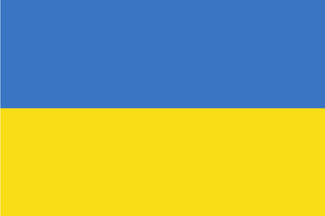
Komancza Republic
|
The Komancza Republic (The Eastern Lemko Republic)
November 5, 1918 - January 27, 1919
Komancza Republic (Republika Komanczanska) was an association of 30 Lemko (Rusyn) villages, founded in eastern Lemko Region in Komancza on November 5, 1918. It had a Ukrainiophile orientation, and planned
to unite with the West Ukrainian National Republic. It was suppressed by the Polish Army on January 27, 1919, during the Polish-Ukrainian War. Its head of state was the President Andrij Kyr.
The flag was identical to the one of the Ukraine. |

Lemko-Rusyn National Republic
|
Lemko-Rusyn National Republic
December 5, 1918 - March 1920
The Lemko-Rusyn National Republic (Ruska Narodowa Republika Lemków) in contrast to the Komancza Republic, which was Ukrainophile, this short-lived Republic had a pro-Russian orientation. Lemko-Rusyn Republic was founded in Florynka on December 5, 1918, in the aftermath of World War I, after the dissolution of the Austro-Hungarian Empire. It originally had the intent of unification with a democratic Russia, and opposed union with the West Ukrainian National Republic. As union with Russia was not possible, it attempted to join with Carpathian Ruthenia on the southern slopes of the Carpathians as an autonomous province of Czechoslovakia.
The republic was headed by the President of the Central National Council Dr. Jaroslav Kacmarcyk. It was ended by the Polish Army in March 1920. Its fate was sealed by the Peace of Riga later that year, following the Polish-Soviet War.
The distinctive, tri-color flag of this short-lived republic is presently used as the ethnic flag of the Lemko minority in Poland. |

Posen/West Prussia Frontier
|
Posen/West Prussia Frontier Province Flag 1920-1935
The Treaty of Versailles granted Poland's independence, which it had already proclaimed in 1918. Germany lost most of Posen and West Prussia provinces of Prussia to Poland, leaving East Prussia and a small section of West Prussia isolated from the rest of Germany by the "Polish Corridor."
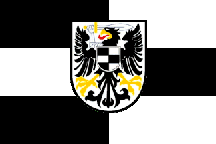 Posen/West Prussia Frontier Province State Flag The portions of Posen and West Prussia provinces remaining in Germany merged to form Posen-West Prussia Frontier province. |

Ostrów Republic Flag
|
Republic of Ostrów Flag 1918
The Ostrowska Republic (Republic of Ostrów), which only lasted between October 10, 1918, and November 26, 1918, was another short-lived republic that existed in the former Grand Duchy of Posen. About a month before the start of the Greater Poland Uprising (Powstanie Wielkopolskie), which would bring the whole area out of German hands and back into Poland in 1919, the citizens of the town of Ostrów Wielkopolski decided to liberate themselves from the Germans and declared themselves the independent Ostrowska Republic. This flag, very obviously an ancestor of the modern flag of Poland, did fly over an independent Republic of Ostrów for that very short period of time.
On October 10, 1918, the newly formed People's Committee of Ostrów issued
their declaration of independence to the Germans, but after a few sporadic skirmishes, the Committee decided it was in over its head, negotiated a few favorable concessions with the Germans, and then, dissolved itself on November 26, 1918. The Greater Poland Uprising started a month later in the city of Poznan (Posen). |
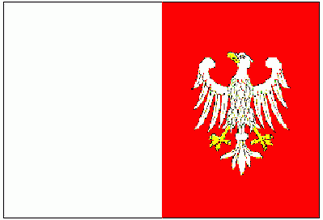
Greater Poland Uprising
|
Greater Poland Uprising 1918 - 1919
Powstanie Wielkopolskie - Großpolnischer Aufstand)
The banner presented here was unveiled in Poznan (Posen) on the first day of what became known as the "Greater Poland Uprising." With Poland's independence regained in 1919, the next task was to consolidate the borders of the country. Germany were reluctant to give any concessions of territory in the Posen (Poznan) province of Prussia. They had signed the separate Peace Treaty with Soviet Russia at Brest Litovsky, totally disregarding any Polish territorial claims, and the Germans were poised to hold on to the Posen Province militarily, if necessary. The Poles were an overwhelming majority there and rose against the German Army to liberate this historical part of their country.
The Uprising broke out on December 27, 1918, in Poznan (Posen) after a patriotic speech by Ignacy Jan Paderewski. Although the German forces were demoralized by the signing of the Armistice on November 11, and the news of the revolutions and rebellions elsewhere in Germany, they put up a heavy resistance to the advancing Polish forces of Polish Military Organization of General Jozef Dowbor-Musnicki. This uprising made a great impact on the decisions of the Versailles Peace Conference and by February of 1920, all of Greater Poland and more, was legally incorporated into the Polish State. |
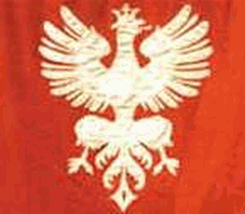
Upper Silesian Uprisings
|
The Upper Silesian Uprisings 1919-1921
(Powstania slaskie - Aufstände in Oberschlesien))
This is one of the banners used by the insurgents during the Upper Silesian Uprisings, which were a series of three armed uprisings of the Poles and Polish Silesians against Germany between 1919 and 1921. Poland was unable to offer any support for the insurgents while fighting for its life against the Soviet invasion from the East. After heavy and vicious fighting, the League of Nations stepped in to resolve the conflicts and by plebiscite the Upper Silesia region was divided between Poland and Germany, with the major industrial cities and coal mines going to Poland.
In 1921, this part of Upper Silesia was incorporated into the Polish State as an autonomous
province (voivodship). |
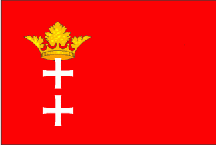
Free City of Danzing

Free City of Danzing
Port Authority 1923-1939 |
Free City of Danzing 1920-29
(Freie Stadt Danzig - Wolne Miasto Gdansk)
The League of Nations, against the wishes of the local population, but in accordance with the Treaty of Versailles, created this semi-autonomous entity under the protectorate of the League and in the customs union with Poland. Although the vast majority of the inhabitants were German and they controlled the local government, Poland owned the railways, got special rights in managing the harbor, run a separate postal services and schools and had a small military presence at Westerplatte to monitor the movement of the eventual military vessels.
In 1933 the Nazi Party took control of the Free City government and openly agitated for the re-unification with the Reich. Germans made several offers to Poland to re-negotiate the status of the Free City, but Poland refused. On September 1, 1939 the Germans assaulted the small Polish garrison at Westerplatte, thus putting in motion the World War II. Two hundred Polish soldiers resisted an assault of almost 4000 Germans, the big guns of the battleship "Schleswig-Holstein" and the bombardments by the Junkers for seven days. The German officer accepting the surrender of the Poles, Gen. Friedrich Eberhardt, was so impressed with the bravery of the Westerplatte's garrison, that he allowed Major Henryk Sucharski to be taken POW with his ceremonial officer's sabre.
Nevertheless, the wireless operator, Sgt. Kazimierz Rasinski was murdered, after brutal interrogation, for refusing to disclose the radio codes. The Polish postal workers and other personnel were all shot dead after surrendering, a total disregard for the international law by the Nazis. Next day after starting the World War II, the Free City was annexed to the Reich. Now, although a totally Polish city, Gdansk's status appears to be in the legal limbo, as neither the Yalta nor Potsdam conferences worked out the fine details of what had been an international territory before the war, except a general statement that it will go to Poland, and now the status of the city can be, potentially, open to the legal challenges. In the final days of the operation to take over the city from the Germans, the Soviets sunk the German ship "Wilhelm Gustloff" with 10 000 evacuees on board including 1000 severely wounded soldiers and sailors. An unending story of tragedies. |
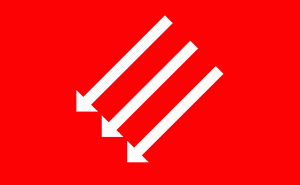
SPD-Danzig
|
SPD-Danzig (Social Democratic Party) 1918-1933
This was the flag is of the SPD-Danzig (Social Democratic Party of Danzig) before it was made illegal and disbanded by the Nazis. Adolf Hitler prohibited the party in 1933 under the Enabling Act and some party officials were imprisoned, killed or went into exile. The symbol of three arrows pointing down was fairly common among the socialists of the day.
What is interesting is that the symbol from this flag today is used as an anti-Fascist symbol worldwide. The symbol is three arrows pointing to the left which seem to have picked up a lot of meanings, including "Liberty, Equality and Solidarity." |
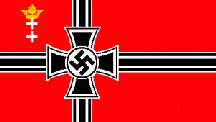
Schutzpolizei Flag
|
Flag of the Danzig Police - Schutzpolizei 1937
This is the flag of the Free City of Danzig Police. It was designed by the Danzig Senate President, Arthur Greiser, who presented it to the police officers at a ceremony in their compound at Hochstriess Street on April 30, 1937 (Hitler's birthday). The Danzig Police used it on festive occasions. |
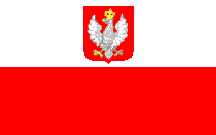
Second Polish Republic 1920
|
State Flag of the Second Polish Republic (Parliamentary Democracy) 1920-1927
This was the State Flag of the Second Republic of Poland, as constituted by Polish parliament in 1919. On land this flag was used as the diplomatic flag abroad. At sea this flag was used as the merchant banner.
It is unknown who designed the coat-of-arms used on this flag, but it closely resembles
the Arms used during the rule of Stanislaus Augustus Poniatowski and the Constitution of 1771. These arms were used already on the flag of the Republic of Zakopane in 1918. The Second Polish Republic took that name as it considered itself a continuation of Res Publica Poloniae, a monarchy, but with the strong democratic basis and the elective system of choosing the Head of State. The crown adoring the eagle's head is therefore a symbol of sovereignty and not of monarchy. This flag with the arms was used as the state flag, a diplomatic flag, and a merchant flag.
|
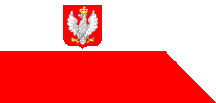
Polish War Flag 1920
|
Second Polish Republic War Flag (Parliamentary Democracy) 1920-1939
A war flag (or military flag) is a variant of a national flag for use by the nation's military forces on land. (The nautical equivalent is a naval ensign.) Under this strict sense of the term, few nations currently have war flags, most preferring to use instead their state flag or standard national flag for this purpose. |
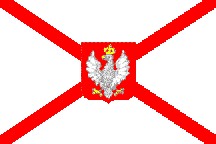
Republic Ensign
|
Second Republic of Poland Ensign (Parliamentary Democracy) 1918
The Polish Navy was called into being in November of 1918, just seventeen days after Polish
independence was declared. The new Navy had two aims: the first was to support Polish claims for the Pomeranian coast; the second was to secure inland waterways in the newly emerged Polish state.
A number of civilian ships were put into naval service, mainly on Vistula river and the construction of river warships was begun. These plans resulted in four gunboats (called monitors in Poland) built in Danziger Werft; a further two were ordered in 1923 at Krakow. Another flotilla was hastily created in the east, preparing for war between Poland and Soviet Russia, comprising mainly ex-German motor boats. The Polish river flotillas, created in 1919 on the Vistula and Pina rivers were at that time the only units of the Polish Navy with any military value. They proved themselves during the Polish-Soviet War of 1919-1920 (the only war lost by the USSR), when they fought gallantly and victoriously against an overwhelming enemy. |
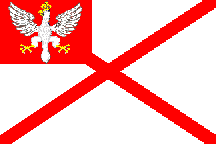
Possible Polish Ensign
(Questionable)
|
Polish Merchant Ensign (Questionable) 1918-1920
This questionable ensign, obviously had a strong influence from Russian ensigns. It is almost identical to flag from the Kingdom of Poland (1815-1930), except St. Andrew's cross is red, not blue. It has been claimed that the first commander of the new Second Polish Republic Navy in 1918 was a former officer of the Imperial Russian Navy, and this was his design that was used between 1918-1920 on the Black Sea.
The ensign's existence is a historical curiosity, and while it is possible that it existed, it is doubtful and remains unconfirmed. The eagle on it is from the times of the Congress Kingdom, which would seem to exclude any official use of this flag in the Second Republic. Most likely, it is felt that it was an ensign used by Polish-owned merchant vessels on the Black Sea in the time of the Russian Revolution (1917-18). A dubious proposal, at best, again probably never existed. |
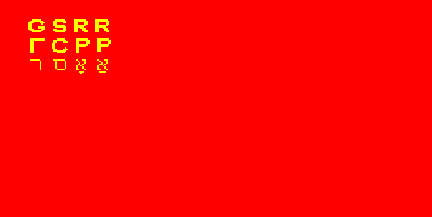
GSSR Flag
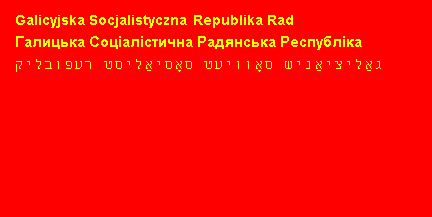
GSSR Flag Variant
|
Galician Soviet Socialist Republic - July to September 1920
In the course of the Polish-Soviet War and initial successes, Lenin ordered the creation of the first two Soviet Republics on conquered territory as a precursor for spreading the Soviet Power all over Europe and the World. The proclamation issued on May 9, 1920, and published in "Pravda" (Communist Party press organ), said: "Forward to the West! On the corps of ´White´ Poland to the liberation of the masses of workers and peasants exploited by the bourgeoisie and landowners all across Europe and the World." They have hoped to rest only after taking Madrid and Lisbon.
The Galician Soviet Socialist Republic was established on July 8, 1920, after the Red troops of the Budionnyi's Horse Army (with Stalin as its political commissar) took Podolia and parts of Galicia (South-Western Front). The Red government was headquartered in Tarnopol (Ternopil) under the leadership of Chairman Volodymyr Zatonsky, an Ukrainian Communist. The official languages of the new republic were Polish, Ukrainian and Yiddish. Waves of severe repressions were soon unleashed, mainly on the Poles. The main prize of the territory, the city of Lwów (L'viv), was never taken due to the successful defense of it by the Polish Army and some Ukrainian units of Petlura. A group of the volunteer American pilots enlisted in the Kosciuszko Squadron of the Polish Air Force and under the command of Major Cedric Fauntleroy and including Captain Merian C.Cooper distinguished themselves enormously wreaking havoc on Budionnyi's Horse Army. Captain Cooper later became a well-known film director and made the movie "King Kong." By September 1920, the Polish troops liberated the area from the Bolsheviks and by the Peace Treaty of Riga (1921) all of Galicia (Galicja-Galizien) went back to Poland.
|
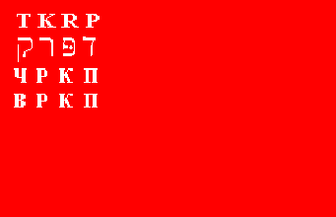
TKRP Flag
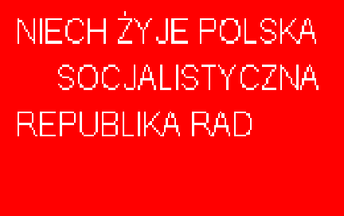
TKRP Propaganda Flag
Text proclaims "Long Live the Polish Socialist Soviet Republic"
|
Provisional Polish Revolutionary Committee - TKRP
(Tymczasowy Komitet Rewolucyjny Polski) July-August 1920
In 1920, although Lenin ordered the creation of Polish Soviet Socialist Republic (Polska Socjalistyczna Republika Rad) as soon as the Red Army entered Poland, Felix Dzierzhynski (Bloody Felix), founder of the Red Terror and the Cheka (later KGB), persuaded him to wait until the Bolshevik forces took Warsaw. Hence, the "Provisional" in the name of the initial government.
Formally, the Chairman of TKRP was Julian Marchlewski, but the de facto ruler was Felix Dzierzhynski. Dzierzhinsky named Polish as the predominant language and, it is said, insisted on white lettering on all flags and propaganda standards in contrast to the usual Soviet gold inscriptions. The TKRP began the formation of a Polish Red Army, but only 176 people volunteered to it and only 7 of them were actually Polish.
After land confiscations and nationalization of the industry, the terror arrests have begun, and, needless to say, the new rulers weren't popular, especially among the Poles. On the eve of the Battle of Warsaw (Miracle on the Vistula) the leaders of TKRP arrived in Wyszkow, near Warsaw, anticipating entry into Warsaw in a day or two and the triumphant proclamation of Polish Soviet Socialist Republic and handing power to the Communist Workers Party of Poland. It was never to be, the Russians were turned back and TKRP left in the hurry.
Marshal Józef Pilsudski, rejecting the defensive strategies suggested by the French and British, led a brilliant campaign resulting in the important victory at Warsaw that stopped communist invasion of Europe. On the staff of the French Military Mission was the young Captain Charles de Gaulle, who later in his career, leading the Free French, used the tactics and strategies learned in Poland from Marshal Pilsudski. All symbols of the temporary Red invaders were destroyed and only one flag is now on display at the Military Museum in Bialystok. It carries the slogans in Polish and Yiddish: "Long Live The Dictatorship of the Proletariat - Communist Workers Party of Poland." |
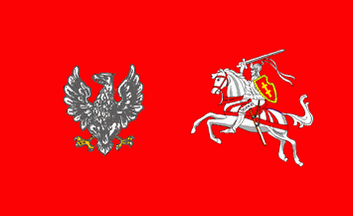
Central Lithuania's First Flag
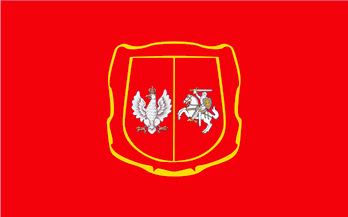
Central Lithuania's Second Flag
|
Central Lithuania (Litwa Srodkowa) 1920-1922
The flags of the short-lived "state" of Central Lithuania only flew for two years. The Town of Wilno (Vilnius in Lithuanian) was, like Lvov (Lwów), considered by the Poles to be one of the most important cultural capitals of their nation. So did the Lithuanians, although the majority population of Wilno and vicinity was clearly Polish. In the course of the Polish Soviet War, first, the Red Army occupied the city, then the Poles pushed them back, only to lose it again in the summer offensive of 1920. At this time the Soviets transferred the city to the Lithuanians as a gift for their friendly neutrality in the Polish-Soviet War. When the Poles beat the Bolsheviks in August of 1920, Wilno was still being under Lithuanian control, so a fake coup d'êtat was staged, with full knowledge and approval of the authoritarian leader of the Second Polish Republic, Marshal Józef Pilsudski.
Polish General Lucjan Zeligowski, ostensibly "rebelled" and acting "on his own" took the city and surrounding area with help of the Polish majority population for Poland. Poland "denied" any involvement, and Zeligowski declared Central Lithuania as an independent state with Wilno as its capital. After his role in "Zeligowski's Mutiny" he became head of the short-lived Republic of Central Lithuania. The fact that Central Lithuania existed was considered a violation of international law by the League of Nations, but, eventually was accepted, disregarding the Lithuanian protestations.
Finally, the Parliament of Central Lithuania asked Poland to incorporate them into the Second Republic, and in 1922, the Polish Sejm accepted that demand. Gradually, the territory of Central Lithuania was transformed into Wilno Voivodship (province) of Poland. |
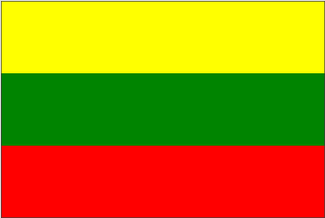
Lithuania
|
Lithuanian Republic 1918-1940
In 1569 the Polish–Lithuanian Commonwealth was formed. The commonwealth was partitioned in 1795 and Lithuania became part of the Russian Empire until 1918. The Council of Lithuania was able to establish the sovereignty in 1919 after Germany lost the World War I.
The first republic of Lithuania existed until 1940 when it was occupied by the Soviet Union. During the Second World War, Lithuania was occupied by Nazi Germany. In 1944, as Germany was losing the war, Russia re-occupied Lithuania and established the Lithuanian Soviet Socialist Republic.
|
- My thanks to Chrystian Kretowicz for all his expert help, research, advise, and images used on this page -
| Learn about "The Evolution of the Polish Coat-of-Arms" Here |
| Top of Page | Medieval Poland 900 to 1599 | 17th and 18th Century Poland 1600 to 1795 |
| Alliance of the Three Black Eagles (Poland Partitioned) 1795 to 1807 | Napoleonic Era and Poland 1807-1824 |
| The Congress of Vienna and its Aftermath 1820-1914 | World War I and the Parliamentary Democracy 1914 to 1926 |
| Second Republic of Poland (Sanacja) 1926 to 1939 | World War II (German and Soviet occupation) 1939 to 1945 |
| People's Polish Republic (Communist regime) 1945 to 1999 | Third Republic of Poland 1999 to present |
|
